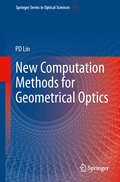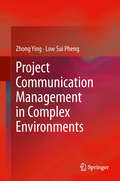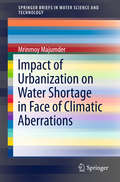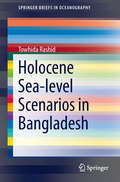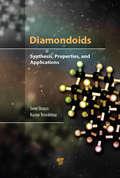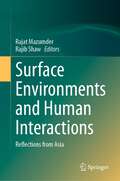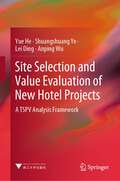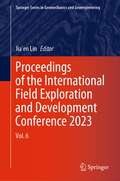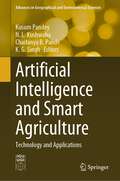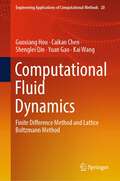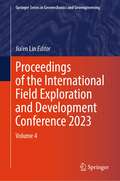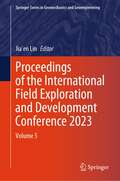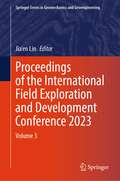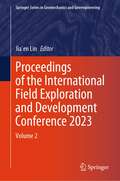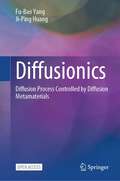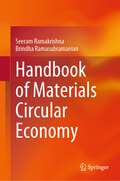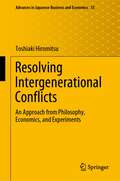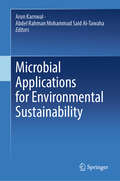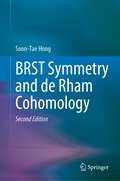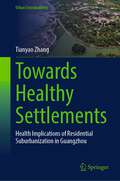- Table View
- List View
New Computation Methods for Geometrical Optics (Springer Series in Optical Sciences #178)
by Psang Dain LinThis book employs homogeneous coordinate notation to compute the first- and second-order derivative matrices of various optical quantities. It will be one of the important mathematical tools for automatic optical design. The traditional geometrical optics is based on raytracing only. It is very difficult, if possible, to compute the first- and second-order derivatives of a ray and optical path length with respect to system variables, since they are recursive functions. Consequently, current commercial software packages use a finite difference approximation methodology to estimate these derivatives for use in optical design and analysis. Furthermore, previous publications of geometrical optics use vector notation, which is comparatively awkward for computations for non-axially symmetrical systems.
Project Communication Management in Complex Environments
by Zhong Ying Low Sui PhengThis unique book that deals with project communication management in complex environments, taking a leaf from China’s experience with a major earthquake in Sichuan, would be a timely contribution to fill this lacuna. Readers would be able to understand how companies and organizations that are unprepared for crisis management would react to their detriment. The lessons provided in this book are the only one of its kind to highlight the lessons for companies and organizations to prepare themselves for successful project communication management through the complexity-informed framework. Although the book is written by two building professionals, the concepts and lessons presented are generic and equally applicable for businesses outside of the construction industry; for example, for airports, resorts, hotels, shipyards, etc.
Impact of Urbanization on Water Shortage in Face of Climatic Aberrations (SpringerBriefs in Water Science and Technology)
by Mrinmoy MajumderThe uncontrolled utilization of natural resources to supply to the water demands of the ever-growing population has brought about worldwide scarcity. The supply shortage has resulted in conflicts between countries, created prolonged drought, closing of industrial units, shifting of local inhabitants etc. The abnormality in climatic patterns due to global warming has only enhanced the uncertainties. Unregulated discharge of waste water into fresh water resources is also polluting the available water resources and making them non-utilizable. That is why the discrepancy between water supply and demand is slowly but steadily becoming a problem, which may lead to conflict and inequality all over the world. The present investigation is an attempt to find the impact of urbanization in the face of climatic uncertainties on water shortage or scarcity. How is climate responsible? What urbanization factors have an influence on the extent of shortages? What is the role of the socio-economic status of the inhabitants? Industrialization? Consumption pattern? Each of the causes and effects were analyzed with the help of data from a climate model, which was then fed into a hydrologic model. The hydrologic output data was then put into various other novel simulation platforms to predict the uncertainties that can be caused by urbanization in various sectors of the regions of interest. The impact was calculated based on IPCC recommended climatic and five distinct urbanization scenarios. The study results will help to predict what is in store of those living in the developing countries. Possible mitigation measures are also discussed.
Holocene Sea-level Scenarios in Bangladesh (SpringerBriefs in Oceanography)
by Towhida RashidThis Brief deals with the reconstruction of Holocene paleoenvironment in the central part of Bangladesh in relation to relative sea-level (RSL) changes which is 200 km north from the present coastline. Lithofacies characteristics, mangal peat, diatom and paleophysiographical evidences were considered to reconstruct the past position and C-14 ages were used to determine the time of formation of the relative sea-level during the Holocene. With standard reference datum the required m.s.l. at the surface of five sections are calculate and the RSL curve suggests that Bangladesh has experienced two mid Holocene RSL transgressions punctuated by regressions. The abundant marine diatom and mangrove pollens indicates that the highest RSL transgression in Bangladesh is around 6000 cal BP which is attained at least 4.5 to 5m higher than the modern m.s.l. After this phase, the relative sea-level started to fall and consequently a freshwater peat developed around 5980―5700 cal BP. The abundant mangrove pollens in salt-marsh succession shows the regression around 5500 cal BP and, the height was 1―2 m higher than the modern sea level. These and more interesting findings are discussed in this Brief.
Earthquake Phenomenology from the Field: The April 20, 2013, Lushan Earthquake (SpringerBriefs in Earth Sciences)
by Zhongliang Wu Changsheng Jiang Xiaojun Li Guangjun Li Zhifeng DingBased on the field investigation and the summary of the published research results of the April 20, 2013, Lushan, Sichuan, China, MS7.0 earthquake, having occurred along the same fault zone which accommodated the May 12, 2008, Wenchuan MS8.0 earthquake, this Brief tries to describe and discuss the special earthquake phenomenology associated with both the local geology and the changing society. Since the occurrence of this earthquake, there have been the scientific debates on (1) the seismo-tectonics of this earthquake which has no primary seismic fault discovered on the surface of the ground; (2) the relation between this earthquake and the Wenchuan earthquake (i.e., whether it can be considered as one of the aftershocks); and (3) how well have been accomplished in the reduction of earthquake disasters, 5 years after the Wenchuan earthquake. This Brief also tries to introduce the studies and practice of Chinese seismological agencies for the reduction of earthquake disasters. Due to language and cultural barriers, such an introduction makes sense not only for English readers but also for Chinese readers. For example, people (abroad) are always asking why there are so many Chinese seismologists working on earthquake prediction. In fact the Chinese wording 'earthquake prediction' has a much wider coverage than that in English. And actually the Chinese approach to (time-dependent) seismic hazard has no systematic difference from outside world in its methodology.
Diamondoids: Synthesis, Properties, and Applications
by Sven Stauss Kazuo TerashimaOver the past few decades, carbon nanomaterials, most commonly fullerenes, carbon nanotubes, and graphene, have gained increasing interest in both science and industry, due to their advantageous properties that make them attractive for many applications in nanotechnology. Another class of the carbon nanomaterials family that has slowly been gaining (re)newed interest is diamond molecules, also called diamondoids, which consist of polycyclic carbon cages that can be superimposed on a cubic diamond lattice. Derivatives of diamondoids are used in pharmaceutics, but due to their promising properties—well-defined structures, high thermal and chemical stability, negative electron affinity, and the possibility to tune their bandgap—diamondoids could also serve as molecular building blocks in future nanodevices. This book is the first of its kind to give an exhaustive overview of the structures, properties, and current and possible future applications of diamondoids. It contains a brief historical account of diamondoids, from the discovery of the first diamondoid member, adamantane, to the isolation of higher diamondoids about a decade ago. It summarizes the different approaches to synthesizing diamondoids. In particular, current research on the conventional organic synthesis and new approaches based on microplasmas generated in high-pressure and supercritical fluids are reviewed and the advantages and disadvantages of the different methods discussed. The book will serve as a reference for advanced undergraduate- and graduate-level students in chemistry, physics, materials science, and nanotechnology and researchers in macromolecular science, nanotechnology, chemistry, biology, and medicine, especially those with an interest in nanoparticles.
Surface Environments and Human Interactions: Reflections from Asia
by Rajat Mazumder Rajib ShawThis book describes the complex interplay between Earth's surface processes (erosion and sedimentation) and human interactions. Intensive as well as extensive research has been undertaken to infer modern sedimentation processes and to infer the mode of stratigraphic sequence building. However, the effort to understand the influence of sedimentation processes on society and the human impact on sedimentation is long overdue. This is a new upcoming multidisciplinary research field that is beyond the scope of leading traditional Earth and Environmental Science journals. To fill in the prodigious gap in the knowledge base, this book includes in-depth reviews and new data-based case studies from Asia, involving multidisciplinary research. It covers case studies of risk management of various hazards and risk management systems at regional, national, and local levels. The book proposes a comprehensive approach to reducing future risks by collaborating with various stakeholders and preparingfor the most effective responses towards complicated hazards, minimizing social damage. This publication will help researchers in the field of Environment and Earth surface processes, disaster risk reduction, and geoscientists to have a better idea of the current trend of research in the field and will provide updated synthesis on this important topic.
Site Selection and Value Evaluation of New Hotel Projects: A TSPV Analysis Framework
by Yue He Shuangshuang Ye Lei Ding Anping WuThe book constructs a holistic analytical framework for the selection of hotel sites and the evaluation of their value, employing the TSPV (Target Analysis—Site Selection—Project Planning—Value Assessment) methodology, particularly in the context of emerging urban (new area) developments.Proceeding from a theoretical foundation in the TSPV paradigm, the book methodically dissects and examines various components such as factor analysis, market feasibility, and financial scrutiny, pertinent to the process of hotel site selection. It adopts an interdisciplinary approach, integrating these elements, while also addressing the ramifications of uncertainty analysis within the hotel industry.Readers can be navigated through the TSPV framework to engage in a scientifically grounded and logically coherent exploration of critical aspects like site selection, strategic positioning, profitability, and the overall valuation of prospective hotel ventures.
Proceedings of the International Field Exploration and Development Conference 2023: Vol. 6 (Springer Series in Geomechanics and Geoengineering)
by Jia’en LinThis book focuses on reservoir surveillance and management, reservoir evaluation and dynamic description, reservoir production stimulation and EOR, ultra-tight reservoir, unconventional oil and gas resources technology, oil and gas well production testing, and geomechanics. This book is a compilation of selected papers from the 13th International Field Exploration and Development Conference (IFEDC 2023).The conference not only provides a platform to exchanges experience, but also promotes the development of scientific research in oil and gas exploration and production. The main audience for the work includes reservoir engineer, geological engineer, enterprise managers, senior engineers as well as students.
Proceedings of the International Field Exploration and Development Conference 2023: Vol. 10 (Springer Series in Geomechanics and Geoengineering)
by Jia’en LinThis book focuses on reservoir surveillance and management, reservoir evaluation and dynamic description, reservoir production stimulation and EOR, ultra-tight reservoir, unconventional oil and gas resources technology, oil and gas well production testing, and geomechanics. This book is a compilation of selected papers from the 13th International Field Exploration and Development Conference (IFEDC 2023).The conference not only provides a platform to exchanges experience, but also promotes the development of scientific research in oil and gas exploration and production. The main audience for the work includes reservoir engineer, geological engineer, enterprise managers, senior engineers as well as students.
Artificial Intelligence and Smart Agriculture: Technology and Applications (Advances in Geographical and Environmental Sciences)
by Kusum Pandey N. L. Kushwaha Chaitanya B. Pande K. G. SinghAs technology continues to saturate modern society, agriculture has started to adopt digital computing and data-driven innovations. This emergence of “smart” farming has led to various advancements in the field, including autonomous equipment and the collection of climate, livestock, and plant data. As connectivity and data management continue to revolutionize the farming industry, empirical research is required to understand these technological developments. This book explores the applications of various artificial intelligence techniques by identifying and describing technical, functional, and non-functional future technologies for smart farming and agriculture. The book also presents practical application opportunities for the resolution of real-world problems, including contributions from precision irrigation, greenhouse data, livestock monitoring, automation, IoT ecosystems for agriculture, cloud computing, mobile robots for precision agriculture, remote sensing applications, anddata mining. In addition, this book provides summary information about different soilless techniques such as hydroponics, aeroponics, and aquaponics, among others. This book is ideally designed for farmers, agriculturalists, product managers, farm holders, manufacturers, equipment suppliers, industrialists, governmental professionals, researchers, academicians, and students seeking current research on technological applications within agriculture and farming.
Computational Fluid Dynamics: Finite Difference Method and Lattice Boltzmann Method (Engineering Applications of Computational Methods #20)
by Guoxiang Hou Caikan Chen Shenglei Qin Yuan Gao Kai WangThis book provides a concise and comprehensive introduction to several basic methods with more attention to their theoretical basis and applications in fluid dynamics. Furthermore, some new ideas are presented in this book, for example, a method to solve the transition matrix by difference operator transformation. For this method, the book gives the definition of Fourier integral transformation of translation operator, and proves the transition matrix equaling to the differential operator transformation, so that it is extended to general situations of explicit, implicit, multi-layer difference equations, etc. This flexible approach is also used in the differential part. In addition, the book also includes six types of equivalent stability definitions in two ways and deeply analyzes their errors, stabilities and convergences of the difference equations. What is more important, some new scientific contributions on lattice Boltzmann method (LBM) in recent years are presented in the book as well. The authors write the book combining their ten years teaching experience and research results and this book is intended for graduate students who are interested in the area of computational fluid dynamics (CFD). Authors list some new research achievements, such as simplified lattice Boltzmann method, the simplified lattice Boltzmann flux solver and discrete unified gas kinetic scheme, and expect that this new information could give readers possible further investigating ideas in their future research on CFD area.
Proceedings of the International Field Exploration and Development Conference 2023: Volume 1 (Springer Series in Geomechanics and Geoengineering)
by Jia’en LinThis book focuses on reservoir surveillance and management, reservoir evaluation and dynamic description, reservoir production stimulation and EOR, ultra-tight reservoir, unconventional oil and gas resources technology, oil and gas well production testing, and geomechanics. This book is a compilation of selected papers from the 13th International Field Exploration and Development Conference (IFEDC 2023). The conference not only provides a platform to exchanges experience, but also promotes the development of scientific research in oil & gas exploration and production. The main audience for the work includes reservoir engineer, geological engineer, enterprise managers, senior engineers as well as students.
Proceedings of the International Field Exploration and Development Conference 2023: Volume 4 (Springer Series in Geomechanics and Geoengineering)
by Jia’en LinThis book focuses on reservoir surveillance and management, reservoir evaluation and dynamic description, reservoir production stimulation and EOR, ultra-tight reservoir, unconventional oil and gas resources technology, oil and gas well production testing, and geomechanics. This book is a compilation of selected papers from the 13th International Field Exploration and Development Conference (IFEDC 2023). The conference not only provides a platform to exchanges experience, but also promotes the development of scientific research in oil & gas exploration and production. The main audience for the work includes reservoir engineer, geological engineer, enterprise managers, senior engineers as well as students.
Proceedings of the International Field Exploration and Development Conference 2023: Volume 5 (Springer Series in Geomechanics and Geoengineering)
by Jia’en LinThis book focuses on reservoir surveillance and management, reservoir evaluation and dynamic description, reservoir production stimulation and EOR, ultra-tight reservoir, unconventional oil and gas resources technology, oil and gas well production testing, and geomechanics. This book is a compilation of selected papers from the 13th International Field Exploration and Development Conference (IFEDC 2023). The conference not only provides a platform to exchanges experience, but also promotes the development of scientific research in oil & gas exploration and production. The main audience for the work includes reservoir engineer, geological engineer, enterprise managers, senior engineers as well as students.
Proceedings of the International Field Exploration and Development Conference 2023: Volume 3 (Springer Series in Geomechanics and Geoengineering)
by Jia’en LinThis book focuses on reservoir surveillance and management, reservoir evaluation and dynamic description, reservoir production stimulation and EOR, ultra-tight reservoir, unconventional oil and gas resources technology, oil and gas well production testing, and geomechanics. This book is a compilation of selected papers from the 13th International Field Exploration and Development Conference (IFEDC 2023). The conference not only provides a platform to exchanges experience, but also promotes the development of scientific research in oil & gas exploration and production. The main audience for the work includes reservoir engineer, geological engineer, enterprise managers, senior engineers as well as students.
Proceedings of the International Field Exploration and Development Conference 2023: Volume 2 (Springer Series in Geomechanics and Geoengineering)
by Jia’en LinThis book focuses on reservoir surveillance and management, reservoir evaluation and dynamic description, reservoir production stimulation and EOR, ultra-tight reservoir, unconventional oil and gas resources technology, oil and gas well production testing, and geomechanics. This book is a compilation of selected papers from the 13th International Field Exploration and Development Conference (IFEDC 2023). The conference not only provides a platform to exchanges experience, but also promotes the development of scientific research in oil & gas exploration and production. The main audience for the work includes reservoir engineer, geological engineer, enterprise managers, senior engineers as well as students.
Diffusionics: Diffusion Process Controlled by Diffusion Metamaterials
by Fu-Bao Yang Ji-Ping HuangThis open access book presents a comprehensive exploration of diffusion metamaterials that control energy and mass diffusion. Currently, if from the perspective of governing equations, diffusion metamaterials and wave metamaterials (pioneered by J. B. Pendry in the 1990s) are recognised as the two most prominent branches in the field of metamaterials. These two branches differ in their emphasis on the diffusion equation (as the governing equation) and time-dependent characteristic lengths in diffusion metamaterials, as opposed to the wave equation (as the governing equation) and time-independent characteristic lengths in wave metamaterials. Organized into three distinct parts – 'Thermal Diffusion Metamaterials', 'Particle Diffusion Metamaterials', and 'Plasma Diffusion Metamaterials' – this book offers a rigorous exploration spanning physics, engineering, and materials science, aimed at advancing our understanding of diffusion processes controlled by diffusion metamaterials. Incorporating foundational theory, computational simulations, and laboratory experiments, the book equips researchers and scholars across these disciplines with comprehensive methods, insights, and results pivotal to the advancement of diffusion control. Beyond facilitating interdisciplinary discourse, the book serves as a catalyst for innovative breakthroughs at the crossroads of physics, thermodynamics, and materials science. Essentially, readers will acquire profound insights that empower them to spearhead advancements in diffusion science (diffusionics) and the engineering of metamaterials.
Handbook of Materials Circular Economy
by Seeram Ramakrishna Brindha RamasubramanianThis book provides comprehensive and practical information on the design and implementation of circular systems for various industries, with a focus on Environmental, Social, and Governance (ESG) factors. The scope of the handbook is to cover the materials circularity in a deeper analysis in accordance to ESG used in various industries such as oil and gas, IT, electronics, medicine, textile, and more. The handbook also covers the key principles of the circular economy, including material efficiency, resource conservation, and waste reduction, and how they impact to different industries. It further critically analyses the challenges and opportunities associated with implementing circular systems in these industries, including the framework for new business models and technical innovations, and the potential benefits in terms of environmental protection, social responsibility, and economic competitiveness. In addition to providing practical information, the handbookalso addresses the ESG factors associated with the circular economy exclusively for each industry. This would include the impact of circular systems on the environment, including the reduction of greenhouse gas emissions and the protection of biodiversity, as well as the social benefits, such as job creation, and the economic benefits, such as cost savings and increased competitiveness. The ultimate goal of the handbook should be to provide guidance and support in a niche evaluation for the development of a more sustainable and equitable future, where the circular economy is a key enabler.
Resolving Intergenerational Conflicts: An Approach from Philosophy, Economics, and Experiments (Advances in Japanese Business and Economics #33)
by Toshiaki HiromitsuThis book is an unprecedented consideration of the challenges of what we can do for generations yet to come. Many growing intergenerational conflicts of interest, such as climate change and fiscal sustainability, are the result of the historically new progress of increasing human power, and the resolution of those conflicts demands a new intergenerational ethic. The book offers fresh new ideas for resolving intergenerational conflicts through the exploration of an entirely new field, conceptualized in philosophy, developed in economics, and tested in experiments. In particular, this work develops the theory of intergenerational cooperation based on a new relationship of direct reciprocity between generations. From experimental results, the possibility of intergenerational cooperation through Kantian categorical imperative is shown. The book also examines the effectiveness of inviting representatives of future generations, which are called "imaginary future generations", into the deliberations for current policy decisions. The original Japanese edition of this book was awarded the 66th Nikkei Prize for Excellent Books in Economic Science. The prize was established in 1958 to contribute to the advancement of academics and knowledge in the fields of economics, management, and accounting, as well as to its general dissemination and application.
Microbial Applications for Environmental Sustainability
by Arun Karnwal Abdel Rahman Mohammad Said Al-TawahaThis book focuses on the various applications of microorganisms for sustainable environment and the reduction of hazardous pollutants released in various forms, including xenobiotics, e-waste, pesticides, insecticides, plastic, heavy metals, paper waste, medical waste, textile dyes, and their impact on environmental and human health. The book involves a series of research reports that explain the application of microbes used to solve real-life issues raised due to changes happening in environment, including pollution, by covering applications, including the use of bacteria, fungi, microalgae and biofilm in the detection and degradation of crude oil, pesticides, dyes, e-waste, heavy metals and other pollutants. It also focuses on integrative strategies in the application of microbial nanomaterials for remediation of pollutant. This material will help environmental scientists and microbiologists to learn about existing environmental problems and suggest novel ways to control or contain their effects by employing various treatment approaches.
Water Resources in the Lancang-Mekong River Basin: Impact of Climate Change and Human Interventions
by Qiuhong Tang Deliang Chen Junguo LiuThis open access book provides a comprehensive, up-to-date picture of the current state of knowledge covering climate change, surface water change, arsenic pollution, water utilization, water-food-energy nexus, water related hazards, water management, and water governance in the Lancang-Mekong River Basin. Considering the widely concerned fact that the climate change and human intervention induced impacts on water will bring unprecedented threats to human societies and ecosystems, the book intends to support UN’s sustainable development goals through sustainable use of water by providing the most accurate and updated information on climate and water changes in a consistent way. Underlying all aspects of the book is a strong commitment to assessing the science comprehensively, without bias and in a way that is relevant to policy but not policy prescriptive. It can provide implications to support decision-makers and stakeholders for integrated water resources management and sustainable development at all levels.
BRST Symmetry and de Rham Cohomology
by Soon-Tae HongThis book provides an advanced introduction to extended theories of quantum field theory and algebraic topology, including Hamiltonian quantization associated with some geometrical constraints, symplectic embedding and Hamilton-Jacobi quantization and Becchi-Rouet-Stora-Tyutin (BRST) symmetry, as well as de Rham cohomology. This extended new edition offers a multifaced insight into phenomenology of particles such as baryons and photons, in terms of extended objects. In particular, in the second edition, the baryons are described in hypersphere soliton model, and the photon properties are additionally included in stringy photon model and in Dirac type relativistic quantum mechanics for a photon.It offers a critical overview of the research in this area and unifies the existing literatures, employing a consistent notation. Although the results presented apply in principle to all alternative quantization schemes, special emphasis is placed on the BRST quantization and its de Rham cohomology group which contribute to a deep understanding of constrained physical theories. The book describes how solitons and other models subject to constraints include rigorous treatments of the geometrical constraints which affect the predictions themselves. The book is intended for use by any graduate-level student with quantum field and relativity theories, and it also serves as a useful reference for those working in the field. An extensive bibliography guides the reader toward the source literature on particular topics.
Remote Sensing Application II: A Climate Change Perspective in Agriculture (New Frontiers in Regional Science: Asian Perspectives #77)
by Tofael AhamedThis book focuses solely on the issues of agricultural productivity analysis with advanced modeling approaches bringing solutions to food-insecure regions of the world, especially in south and southeast Asia and in Africa. Advanced modeling tools and their use in regional planning provide an outstanding opportunity to help face the challenges of climate change. The sudden effect of flash floods, drought, salinity, and sea water rises causing saltwater intrusions and its impact on agricultural production are some of the disastrous results of climate change. In this edited volume, information on climate-induced impacts for flooding, flash floods, and drought impact on agricultural crops is provided to address possible solutions for food security in south Asia, southeast Asia, and some regions of Africa. Leading-edge research methodology is presented as it relates to remote sensing applications for regional science and allied fields. In regional policy planning, agriculture andforestry play key roles in food security along with environmental conservation and depend on geo-spatial variability. Satellite remote sensing and geographical information systems have an immense potential to encompass all these factors and to catalogue the regional variability of climate change and climate economics. In the satellite remote sensing domain, advanced modeling tools, deep learning applications, and cloud-based earth engines significantly increase the flexibility of decision making and its application for regional perspectives. The result can increase agricultural and forest productivity and ensure its resilience and sustainability. The book’s chapters introduce modeling techniques such as machine learning and fuzzy expert system using satellite remote sensing datasets based on cloud application. These methods assist regional planners to increase crop production, land use, and detection of changes in land cover in order to better understand their vulnerability toclimate-related disaster. Furthermore, remote sensing and in-depth GIS analysis are integrated with machine learning to address natural uncertainties such as flash floods, droughts, and cyclones so that emergency responses for agricultural production management can be adopted more effectively.
Towards Healthy Settlements: Health Implications of Residential Suburbanization in Guangzhou (Urban Sustainability)
by Tianyao ZhangThis book aims to formulate recommendations for achieving a healthy neighborhood living environment for the middle-income people in China‘s suburbs. In China, the expeditious urbanization triggers the prosperous commodity housing development, which further grows with the spatial restructuring and socioeconomic transition. Residential suburbanization is generated, accompanied with the emergence of new-middle class and the change of lifestyle. However, the health effects of suburbanization in China are overlooked. This book investigates the health performance of suburban residents and the effects of suburban living on residents‘ health. This book also examines the resident-environment transaction modes to unfold the underlying mechanism of suburban living affecting residents’ health. Suburban residents had to passively adapt to their residential environment, which is the obstacle for achieving a health-promoting environment. The institutional dynamics determining the health performance of suburban living environment were addressed with the roles of governments, developers, planners, housing managers, residents‘ committee, and ordinary residents in commodity housing development. The book found no institutional support for the creation of health-promoting environments, especially with default of governments and excessive dependence on developers for public service facilities and the absence of civil society. Thus, the book proposes that institutional innovations are necessary in term of embedding the health dimension in all sectors of the society, enlisting collaboration between public and private sectors, and between health and non-health sectors, and thus cultivating the optimization of residents-environment transactions to create health-promoting environments.
